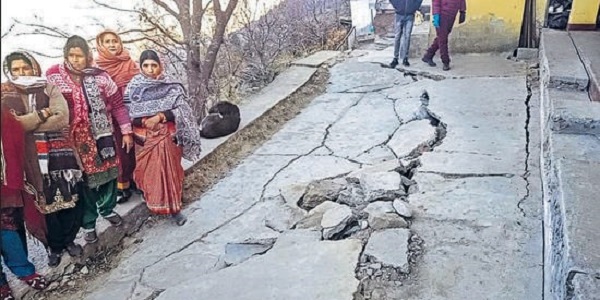Joshimath Crisis- Highlights, Reasons & Concern

From Current Affairs Notes for UPSC » Editorials & In-depths » This topic
IAS EXPRESS Vs UPSC Prelims 2024: 85+ questions reflected
Following recent developments in Joshimath, it is feared that the Himalayan town may be on the verge of extinction. If things aren’t controlled soon, other major areas in Uttarakhand like Mussoorie, Nainital and Dharchula may soon face a similar situation.

What happened in Joshimath?
- Joshimath is a hill station in Chamoli district of Uttarakhand. It is an important pilgrimage destination and is en route to 3 other important pilgrimage sites- Badrinath, Kedarnath and Hemkund Sahib.
- Recently, a land subsidence episode led to cracks forming in over 600 houses in the town. Similarly, the roads and fields were also damaged.
- The town’s utilities, like high tension power lines, are also being affected by the sinking.
- The trees in the area, including the apple trees, have started collapsing.
- The town’s residents have evacuated their houses following the incident.
Why is it sinking?
- Anthropogenic activities have been playing a major role in the destabilization of Joshimath. The area has seen an unregulated mushrooming of hotels and other tourist infrastructure. The population pressure, added to by the tourist inflow, is also contributing to the destabilization.
- The Tapovan Vishnugad Hydro Power Project is being blamed as one of the factors contributing to the recent subsidence:
- It is being constructed on the Dhauliganga River, in Chamoli district, by the National Thermal Power Corporation.It is expected to produce over 2.5 TWh/ year.
- While the NTPC has denied the project’s role in the recent events, the Tapovan project has a history of disrupting the complex hydrogeology of the region.
- In 2009, tunnelling activity punctured an aquifer- an incident that is expected to have long term consequences as pointed out by Garhwal University scientists.
- Another aquifer was breached in 2012. Such sudden large-scale de-watering increases the risk of land subsidence.
- When large volumes of groundwater are withdrawn from some rock types (like fine grained sedimentary rocks), land subsidence takes place. This is because the water plays a supporting role in holding the land up and when it is removed, the land weakens and collapses.
- The town is located in a seismic zone V i.e. highly prone to earthquakes. The region experiences tremors regularly and the top soil has been rendered unstable.
- The 1976 Mishra Committee observed that Joshimath is situated on an old landslide zone, on a deposit of sand and stone, as opposed to the main rock. Thus the region isn’t suited for a township in the first place. In addition to the water percolation and gradual weathering of the land, vibrations from heavy traffic and other anthropogenic activities would destabilize the region.
Why is it a concern?
- Such large-scale infrastructural damage endangers lives in the thousands. For instance, the Joshimath subsidence put some 3,000 people at risk.
- While people have evacuated the houses out of safety concerns (that the houses may collapse), they were left unsheltered out in the open, in the midst of a freezing winter.
- This isn’t a recent development. In August 2022, an expert team noticed similar cracks in several parts of Chamoli. It pointed to unscientific tourist activity as a key contributor and recommended improving the drainage facilities and reducing erosion along the Alaknanda river, especially along the segment north of Joshimath.
What is the way ahead?
- The recent subsidence in Joshimath is turning out to be the 2nd major turning point in the history of disasters in Uttarakhand- after the 2013 Kedarnath floods triggered by cloudbursts.
- However, the current incident is a result of apathy, for it has been widely known that the region and its ecology is highly fragile. Reports explaining the nature of the region has been available from as far back as 1976. Subsequent studies have also highlighted similar concerns. These reports have been left unheeded.
- Now, the people of Joshimath are protesting. They are demanding permanent rehabilitation from the government. They are calling for an immediate stop to construction activities in the area, including the Char Dham Yatra project.
- The government is rightly prioritizing the residents’ safety for now. It has asked scientists from Geological Survey of India, the National Disaster Management Authority and National Institute of Hydrology to formulate a “risk-sensitive urban developmental plan”, for the region.
- The first step towards reimagining development in the Himalayan states is to revisit earlier studies and report on the region and heed their warnings.
- The way ahead is proper micro-zonation and improvement of construction materials and methods, while maintaining humility in our interactions with nature.
Conclusion:
The Joshimath crisis speaks volumes of our failure to respect the Himalayan system’s special characteristics, in our pursuit of economic development. The recent incident could be taken as a lesson in the importance of sustainable development.
Practice Question for Mains:
What are the factors that contributed to the Joshimath crisis? What is the way ahead? (250 words)
If you like this post, please share your feedback in the comments section below so that we will upload more posts like this.


WUT